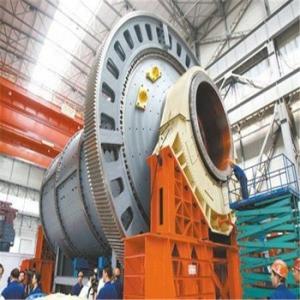Grinding Machine Sag Mill Ore Grinding Mill With High Wearable Liners
Add to Cart
Long service life grinding machine sag mill with high wearable liners
SAG Mill: φ2.4x1.2~φ13x4.0m,Effective volume 5.6~216m3
Feature of SAG mill:
♦The cylindrical mill adopts the driving type edge-driving,
center-driving, edge-driving with multi-point meshing, etc; driven
by asynchronous motor +reducer +pinion and gear as well as
synchronous motor +
air lclutch + pinion and gear.
♦Generally supported by static-dynamic pressure bearing on both
ends. Fuuly closed self-aligning 120º osculation rocker bearing is
used. Also single or double slipper staic- dynamic bearings can be
used. The bush is made by NC machine.
♦ The large open gear is designed using AGMA standard, Equipped
with reliably sealed gear housing and grease ahtomatic spraying
lubrication system.
The shell is key part of a mill. Carry out finite element analysis
on it with computer to ensure the reliable operation;
♦ The shell is automatically welded, ultrasonic inspected, wholly
annealed and machined by large special machine tools on one
chucking; there special seal on static-dynamic connection parts ,
ch as feed and discharge hoper, trunnion, etc, to prevent oil and
slurry leakage;
♦ The liner is of wear-resistance material mad by our company, wich
has been specially heat-treated, with high hardness and long
service life. Also other wear-resistance casting or rubber liner
can be used;
♦ There are slow speed drive for medium and large mill;
♦The high and low pressure lubricating station is equipped for
medium and large mill;
♦The control and protection system is controlled by PLC.
Description of Semi Autogenous Mill(SAG Mill):
This semi-autogenous mill, also called semi-autogenous grinding
mill or SAG mill, is mainly used to grind ores and other
particulate matter in different fields, like chemical industry,
mining field, metallurgy industry, building material sector, and so
on.
It is an autogenous mill in nature, but it employs grinding balls
to assist in its grinding just like in a ball mill. And it is
mainly used in the first stage of grinding. When compared with a
ball mill, it is characterized by its larger diameter and shorter
length. The inside of it is lined with lifting plates to lift the
materials inside up and around the inside of the mill, where it
then falls off the plates into the rest of the ores. And it is
widely used to process gold, copper, lead, zinc, alumina, nickel,
platinum, etc.
Semi-Autogenous (SAG) grinding mills have seen increased
application in large mineral processing operations in recent years.
They are rotating/tumbling mills in which comminution (size
reduction) takes place without grinding aids. Consisting of a large
diameter cylinder relative to their length (typically 2 or 2.5 to
1) these mills use large lumps of ore as the grinding media.
Autogenous mills use ore exclusively as their grinding media but if
hardness and abrasiveness of the ore does not lend itself well to
full AG milling then a small charge of steel balls (6 to 15%) is
added to assist in size reduction. This is known as a
Semi-Autogenous (SAG) mill. SAG mills bring about size reduction by
a combination of impact, attrition and abrasion forces. Ore is
swept up one side of the mill and at a certain point it falls back
to impact the toe of the charge (bottom of mill). Ore particles in
the body of the charge slide when moving to different heights and
are subjected to attrition and abrasion forces. The inside liner of
SAG mills consists of steel or rubber liners and are fitted with
lifter bars.
SAG mills can accomplish the same size reduction work that normally
takes multiple stages of crushing, screening and grinding methods
which accounts for its popularity. Often the product can be
finished size or ready for final grinding in a ball mill or pebble
mill. They can grind run-of-mine rock or primary crusher products
with their feed size limited to what can practically be conveyed.
In addition they can be less costly to operate with the reduction
or elimation of expensive balls or rods.
Parameters of Semi Autogenous Mill(SAG Mill):
| diameter (mm) | Cylinder length (mm) | Effective volume of cylinder (m3) | Max. ball loading capacity (t) | Rotate speed (r/min) | Power of main motor (kw) |
| 4000 | 1600-3600 | 19-42 | 13-29 | 16.2 | 310-710 |
| 4500 | 1800-4100 | 27-61 | 19-43 | 15.3 | 470-110 |
| 5000 | 2000-4500 | 38-83 | 27-58 | 14.5 | 700-1500 |
| 5500 | 2200-5000 | 51-112 | 36-78 | 13.8 | 960-2200 |
| 6100 | 2400-5500 | 69-152 | 48-106 | 13.1 | 1400-3100 |
| 6700 | 2700-6000 | 93-201 | 65-140 | 12.5 | 2000-4300 |
| 7300 | 2900-6600 | 120-264 | 84-184 | 12 | 2600-5900 |
| 8000 | 3200-7200 | 160-347 | 112-242 | 11.4 | 3600-8100 |
| 8600 | 3400-7700 | 197-429 | 137-299 | 11 | 4600-10000 |
| 9200 | 3700-8300 | 246-530 | 172-370 | 10.7 | 5900-13000 |
| 9800 | 3900-8800 | 296-640 | 206-446 | 10.3 | 7300-16000 |
| 10400 | 4200-9400 | 359-770 | 250-537 | 10 | 9100-20000 |
| 11000 | 4400-9900 | 422-909 | 294-634 | 9.8 | 11000-25000 |
| 11600 | 4600-10400 | 492-1064 | 343-742 | 9.5 | 13000-30000 |
| 12200 | 4900-11000 | 580-1246 | 405-869 | 9.2 | 16000-36000 |




